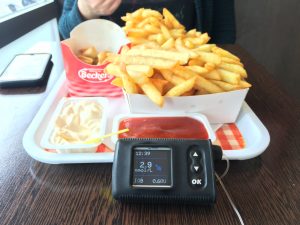It’s been a bit of a stressful week for me for numerous reasons, but instead of boring you with the details of what stresses me out I’ll just tell you that my blood sugars were definitely paying for it. This is not the first time I have experienced high blood sugar as a result of stress so I decided to feed my curiosity and find out why stress plays such a role in hyperglycaemia.
It’s quite simple really; when a person is either physically or emotionally stressed the adrenal gland releases some glucose as a response. I’m not going to pretend to be a doctor so here is the link to a Diabetes UK article that explains the whole thing much better than I could.
Pin pointing the cause of stress is probably the most useful tool you can use in stress management.
I spend a lot of time working on and thinking about my body so I feel like I’m very in tune with signals caused by a physical stress such as injury. However, it takes me a bit longer to recognise an emotional stress, especially when it is combined with high blood sugar as I would probably just put the stress down to high blood sugar and go in a circle from there.
This makes it difficult to eliminate the cause of stress.
So, when I see unexpected high BG on my meter I always ask myself if I am stressed about anything. If the answer is yes I will take the following steps to not only reduce stress, but to also decrease the blood sugar.
Walk
The other day, my blood sugar spiked to 10mmols due to stress so I decided to stretch my legs and walk it off. Walking at a fast pace for 30 minutes, with a rucksack on my back and 1 unit of insulin on board, decreased my bg by 7.5mmols. Proving that walking is a great way to reduce bg. As for my emotional stress, I listened to some music on my headphones whilst I was walking and it helped a lot.
An alternative method to this would be to do any exercise you love. Sometimes I just dance. Like literally, I will drop what I’m doing and dance. Yes, I look as crazy as it sounds but dancing is as natural as walking to me. Try it.
Make a Change
When I notice that stress is recurring because of the same thing I try to make a change. For instance, for a few months I would not give myself a day off from doing some sort of work. I am the type of person that will not stop until something is completed, even if it means getting stressed out. However, when I saw what this was doing to my levels I had to make a change.
I started to take a day of rest each week in order to replenish my mind and reenergize my body. I still find this very difficult because rest makes me feel guilty, but I’m sure I will adjust at some point because my blood sugar definitely appreciates it.
I understand that immediate change might not be possible for some;– if your work is stressing you out it might not be a good idea to quit right away (unless you have another to walk into) but you could put a plan in place to reduce the level of stress you are feeling right now. A plan will help you see that there is a way out of your current situation which will, in turn, help prevent the high blood sugars caused by stress at work.
Meditate
I’m sure you’ve heard this before but mediation does actually help. Especially if you have a tendency to overanalyse things or if you sweat all of the unnecessary small stuff. At first it can be very difficult to stay calm in the face of something we see as an intense situation; an argument with a family member or a friend, the loss of something or someone, or a big change. We can get wrapped up in what is important and what is not.
This is where mediation comes in.
Meditation brings clarity and focus, making space for you to breathe and relax.
A great way to meditate is to sit in a comfortable position or lie down, close your eyes and focus on the rhythm of your breath. Count how many seconds it takes you to breathe in and how many seconds it takes to breathe out.
Hopefully this will help a little bit if you are experiencing any sort of stress.
In a way, although I really hate the feeling of being stressed and hyperglycaemic, it makes me grateful for diabetes because I have another way of listening to what my body is telling me. I have a clearer understanding of what it worth stressing about and what isn’t. The majority of the time its just not even worth it.
Stay healthy.
Rowena x
Are you following Type 1 Active on Twitter, Instagram, Facebook and Youtube?














